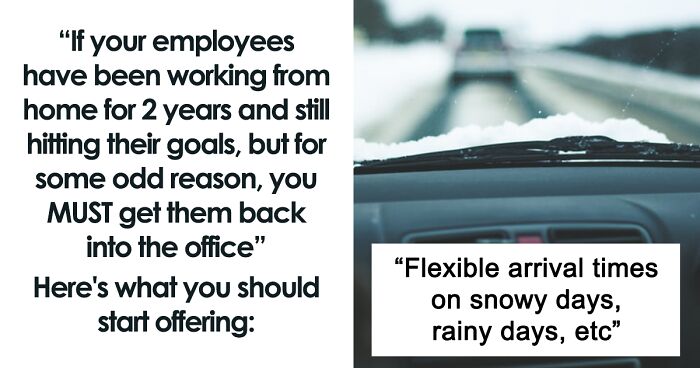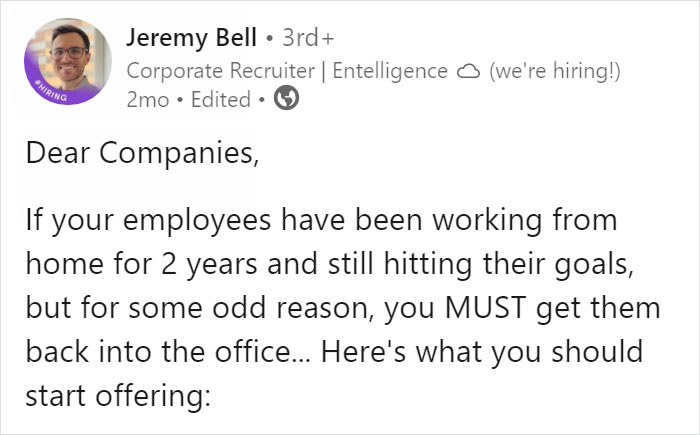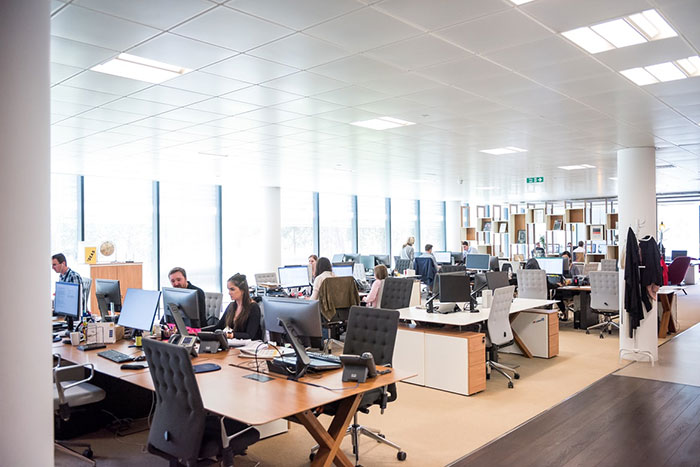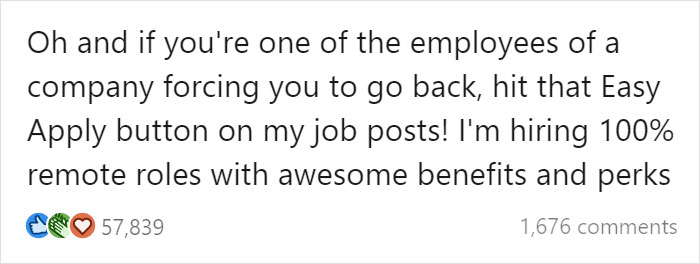
“Free Lunch Every Day”: Recruiter Explains What Companies Need To Offer After Demanding That Workers Come Back To The Office
After two years of trying to navigate the ups and downs of remote work, many employees felt the obvious benefits of working from the comfort of their own homes. But now, accusatory murmurs are flying around the business world that employers appear on the brink of making their employees go back to the office full-time, whether they are ready or not.
Whether it’s saying that face-to-face interactions are better for teamwork or that the WFH model affects productivity, this only adds more fuel to the fire and creates heated discussions online. And there’s no better place to share hot takes about corporate culture than the notorious professional network LinkedIn.
A few months ago, recruiter Jeremy Bell did just that by creating a post that quickly went viral. He listed several things companies should offer when they leave their employees no choice but to head back to their good old offices. So continue scrolling to read the full post, which amassed nearly 58K likes on the platform, and take a look at how people reacted to it. After you’re done, be sure to share your own opinions about these suggestions in the comments below!
While remote work has become a dealbreaker for many, countless companies are forcing workers to head back to their offices
Image credits: Unsplash (not the actual photo)
So corporate recruiter Jeremy Bell decided to list the things employers should offer if they want to attract and retain talent
Image credits: Unsplash (not the actual photo)
Image credits: Unsplash (not the actual photo)
Image credits: Jeremy Bell
According to a recent Microsoft survey of over 31K workers worldwide, a change in the WFH model seems to be on the horizon, no matter the protests of countless irritated workers. The research found that around 50 percent of leaders said their company already requires or is planning to require employees to return to the office full-time in the next year. Yet, workers do not share the same amount of excitement about returning to work in-person as their employers.
“A lot of business leaders have told me that they don’t believe in hybrid work, that it has no place in their culture,” Elise Freedman, a workforce transformation practice leader who is helping companies coordinate their return-to-office plans, toldCNBC Make It. “But the companies who push for a full return-to-office could see serious ramifications if they don’t offer employees the kind of flexibility and environment they’re asking for … they’ll just leave.”
Another study by the Future Forum which was developed by the workplace-messaging platform Slack only proves this. After surveying more than 10K workers and managers globally, the researchers found a vast and growing divide in how executives and employees anticipate the future of work, and called it “the great executive-employee disconnect”.
You see, more than half of executives said they are planning the “post-pandemic” workforce policies with little to no direct input from the workers themselves. And while the same number of executives (66 percent) believe they’re being “very transparent” regarding these policies, just 42 percent of workers agree.
Among executives who worked completely remotely at the time of the survey, nearly half reported they want to work from the office every day, compared to 17 percent of employees. Moreover, three-quarters of leaders said they prefer to be at the office three to five days a week but just about one-third of workers said the same.
Moreover, executive overall job satisfaction is now 62 percent higher than non-executives, and it’s driven by higher scores on flexibility (51 percent higher), work-life balance (78 percent higher), and a whopping 114 percent better on “feeling good about stress and anxiety.”
These results do beg the question, what do employees actually want? In these past few years of working from home, employees got a taste of the benefits of remote jobs, and flexible work practices got deeply ingrained and valued in their everyday life. So it’s no surprise that 76 percent of employees want flexibility in where they work, and 93 percent want flexibility in when they work.
When companies and employers fail to put in the effort to understand their staff’s wants and needs, they are bound to watch them leave in droves. Out of employees who reported low satisfaction with flexibility on the job, 71 percent are open to new opportunities. Moreover, 72 percent of workers who reported a low sense of belonging are open to making a job switch. Well, employees are definitely monitoring the new return-to-office policies. And the Great Resignation made sure they would have more options today than ever before.
“Studies show that many executives are holding on to the remnants of the past and failing to see this as an inflection point in the workforce,” Dr. Ella Washington, organizational psychologist and faculty member at Georgetown’s McDonough School of Business, stated in the study. “If employers don’t pay attention and take action to re-create the best of what we’ve learned working virtually in the office and in hybrid-work environments, then opportunities for inequity could skyrocket.”
“Executives have to overcorrect for this possibility now because by the time the return-to-work trends for marginalized groups become clear, it’ll be too late — they’ll be losing talent to companies that were intentional now and did it right.”
Here’s what people had to say about the LinkedIn post
Why the push to get back into the office? All those greenhouses gasses from commuting, wasted time, car accidents stress...
Inflated office space rental, heat, A/C, electric, water, office furniture, etc, etc, etc costs could save companies so much they could pay their employees better. You may ask what we’d do with all the empty office buildings? Convert them to affordable housing for people who are somewhere between dirt poor and filthy rich.
Load More Replies...I wouldn't be surprised in the slightest if companies start to move 'work from home' jobs overseas for cheaper labour costs. We've seen it happen plenty of times with customer service.
We can't go back. Our company subleased two-thirds of our office space during all of this; a full staff returning to the office is logistically impossible.
Why the push to get back into the office? All those greenhouses gasses from commuting, wasted time, car accidents stress...
Inflated office space rental, heat, A/C, electric, water, office furniture, etc, etc, etc costs could save companies so much they could pay their employees better. You may ask what we’d do with all the empty office buildings? Convert them to affordable housing for people who are somewhere between dirt poor and filthy rich.
Load More Replies...I wouldn't be surprised in the slightest if companies start to move 'work from home' jobs overseas for cheaper labour costs. We've seen it happen plenty of times with customer service.
We can't go back. Our company subleased two-thirds of our office space during all of this; a full staff returning to the office is logistically impossible.

 Dark Mode
Dark Mode 

 No fees, cancel anytime
No fees, cancel anytime 








































































111
80